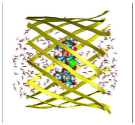


|
PNII-ID-PCCE-2011-2-0027 |
|
BIOSENS |
|
Project type: PNII-ID-PCCE-2011-2-0027
Description of the Project: Development of nanostructures capable of detecting and separating individual molecules and ions has become an important field of research. Particularly, protein-based nanostructures are attractive due to their ability for tunable molecular recognition and ease of chemical modification, which are extremely important factors on various applications. In this project, self-assembly functionalization will be approached, aimed at providing an efficient design for molecular recognition, ion sensing and separation, through new host-guest chemical methodologies, bio-nanofabrication and physicochemical manipulations methods. New crown ether type macrocycles, functionalized cyclodextrins and cyclic peptides will be engineered to work as specific molecular adaptors for the a-hemolysin protein, giving rise to hybrid molecular superstructures possessing ion sensing and selectivity properties. The size and functionality of the macrocycles are targeted to ensure the anchorage in the pores and the selectivity of specific host-guest complexation processes. A surface detector array device suitable for use with a biosensor is envisioned, through ink printing nanotechnologies. The device architecture will be formed of a substrate having a surface defining a plurality of distinct bilayer-compatible surface regions separated by one or more bilayer barrier regions. Custom designed nanoscale bilayers containing selected receptors through cyclodextrins derivatives and macrocyclic peptides, self-assembled on different micro-nano arrays surfaces (polymers, Au or Si) will be fabricated. Further engineering of such functionalized nanomaterials based on molecular recognition and host-guest methodologies, in conjunction with flexible and mechanically robust enough substrate platforms, have the great potential for applications such as separation of nanoparticles, sensors, drug delivery, removal of heavy metals from aqueous solutions and chiral separation.
Purpose of the project: The aim of this project is to approach in a multidisciplinary and collaborative perspective, from a theoretical and experimental point of view, the functionalization of nanostructures through self-organization of proteins in order to ensure an efficient design for molecular recognition, separation and ion detection based on new chemical methods of "host-guest" type, bio-nanofabrication and physico-chemical handling techniques. Also, using "ink-printing" nanotechnologies, we intend to build a device suitable for surface detection, based on such molecular nanosensors.
Selected Objectives: The project obiectives aim at obtaining some host systems such as cyclic peptides or crown ether type macrocycles, incorporated in α-HL pores or deposited on gold and silica surfaces, having role in the detection, separation and quantification of various analytes. Other objectives of the project are the following: testing the novel molecular systems based on molecular adaptors, which should be able to detect, separate and quantify specific ligands; design and characterization of functionalized molecular SAMs and testing of functionalized surfaces for selective attachment of cells. |
|
ION SENSING AND SEPARATION THROUGH MODIFIED CYCLIC PEPTIDES, CYCLODEXTRINES AND PROTEIN PORES (BIOSENS) |


|
This project is funded under the National CDI Plan 2007 - 2013 UEFISCDI and is part of the category: Complex Projects of Exploratory Research. |